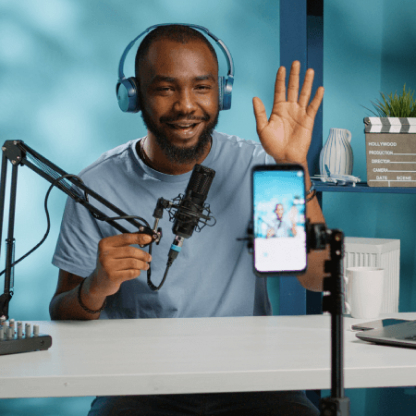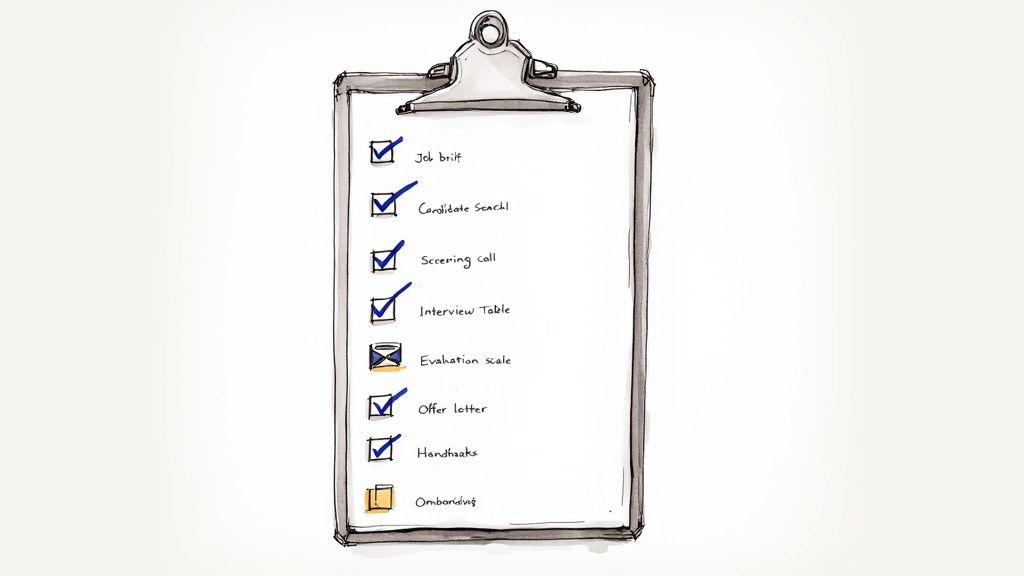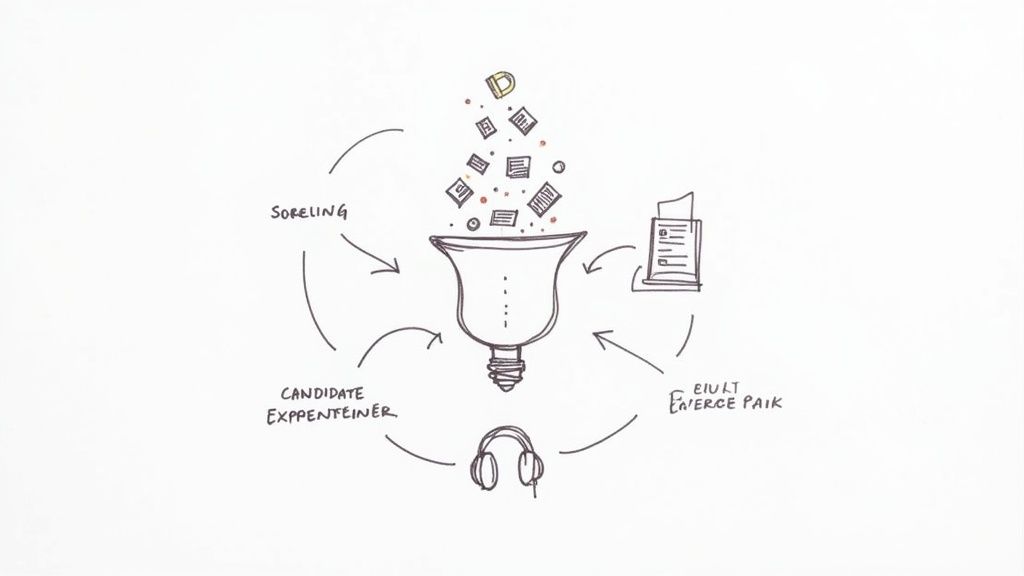Let's be honest. Most interview advice is recycled fluff. You've read the same lists a dozen times, and they haven't stopped you from making a bad hire. The problem isn't just the questions; it's the why behind them. I've spent years in the hiring trenches, building teams from scratch and, yes, making a few painful missteps along the way. I’ve learned that the secret to a great hire isn't a magical question but understanding what a simple question can truly reveal, especially through the lens of a video interview.
Turns out there’s more than one way to find top talent without mortgaging your office ping-pong table. In a world of remote work and asynchronous screening, your questions have to work harder. They need to cut through the rehearsed answers and get to the core of a candidate's competence, motivation, and character. This isn't just another list. This is a battle-tested playbook of questions for video interview scenarios, complete with the insider analysis you need to stop guessing and start hiring with confidence. We’re not saying we’re perfect. Just more accurate more often. (Toot, toot!)
1. Tell me about yourself
Let’s start with the classic, the interview opener that’s so common it’s become a cliché. But don’t be fooled by its simplicity. Asking "Tell me about yourself" isn't just a warm-up; it's a diagnostic tool disguised as a friendly chat. This question is your first real test of a candidate's ability to communicate, prioritize information, and connect their story directly to the role you’re trying to fill. It sets the entire tone. A fumbled answer here can signal a lack of preparation or self-awareness that’s hard to recover from.

This question separates the candidates who have done their homework from those who are just winging it. It's one of the most fundamental questions for video interview preparation, yet you'd be surprised how many people get it wrong. Their answer reveals if they see themselves as a problem-solver for your company or just another person looking for any job.
Strategic Breakdown
So, what are you actually looking for with this question? It’s not their life story or a list of hobbies. You’re evaluating three key things in under 90 seconds:
- Clarity and Structure: Can they craft a compelling narrative, or do they just ramble? A great answer is a tight, logical "elevator pitch."
- Relevance: Have they connected their experience directly to the job description? This shows they’ve done more than just glance at the title.
- Confidence: How do they present themselves on camera? Eye contact, clear speech, and confident body language are all indicators of their professionalism.
Key Insight: The best answers follow a "Present-Past-Future" model. They start with their current role (Present), connect it back to relevant past experiences (Past), and pivot to why this specific role is the perfect next step (Future). This structure is a godsend for keeping candidates focused and on-topic.
Real-World Examples
- Google: Uses this to quickly gauge communication skills and cultural alignment. They want to see if a candidate can be concise and articulate their value proposition from the get-go.
- Amazon: Often listens for hints of their 14 Leadership Principles in the answer. A candidate mentioning a past project where they showed "ownership" or "customer obsession" is already scoring points.
- Microsoft: Looks for how candidates integrate their technical background into their story. They want to hear about specific technologies and projects, not just generic career summaries.
2. Why are you interested in this position/company?
After the "Tell me about yourself" opener, this is your first real gut check on a candidate's motivation. This question cuts through the noise of mass applications and reveals who genuinely wants this job at this company, versus who just wants any job. It’s a powerful differentiator. Their answer tells you whether they’re an informed admirer of your work or just another tourist passing through your application portal.

This question separates the truly invested from the merely interested. Answering it well is a non-negotiable part of preparing for questions for video interview scenarios, yet many candidates offer vague compliments about your "great reputation." You're looking for specificity that proves they’ve done more than a 30-second Google search. You want to see the spark that says, "I belong here."
Strategic Breakdown
So, what are you listening for beyond flattery? You're assessing their alignment with your mission, culture, and specific challenges. A top-tier response demonstrates:
- Genuine Enthusiasm: Can you hear passion in their voice? Their answer should reflect a personal connection to your company's mission, products, or values.
- Deep Research: Have they mentioned a recent company milestone, a specific project, or a quote from your CEO? This proves they’ve put in the work.
- Strategic Alignment: Do they connect their own career goals to the opportunities this specific role provides? This signals long-term potential, not just a stepping stone.
Key Insight: The most compelling answers weave together a three-part story: company admiration, role alignment, and personal connection. They admire what your company does (the "why you"), see how the role fits their skills (the "why this job"), and connect it to their personal values or career trajectory (the "why me").
Real-World Examples
- Tesla: Actively screens for candidates who can articulate a passion for the mission of accelerating the world's transition to sustainable energy, not just those who think the cars are cool.
- Netflix: Looks for candidates who reference and align with their unique culture of "freedom and responsibility." Mentioning how they thrive in that specific environment is a huge plus.
- Salesforce: Values candidates who bring up their commitment to equality and community philanthropy (the 1-1-1 model). This shows they understand the company's core ethos.
3. Describe a challenging situation and how you handled it
This is where the interview gets real. Asking a candidate to describe a challenging situation isn't about enjoying a dramatic story; it’s a surgical strike to uncover their resilience, problem-solving skills, and professional maturity under pressure. It’s one of the most revealing questions for video interview scenarios because it moves beyond hypotheticals and into proven history. Their answer shows you exactly how they behave when things go wrong, which, let's be honest, they inevitably will.

This question separates the problem-solvers from the problem-blamers. You're not looking for someone who has never faced a challenge; you're looking for someone who faced one, owned it, and grew from the experience. A candidate who can articulate this clearly demonstrates a high level of self-awareness and accountability, two traits that are priceless in any role. Learning how to answer this is essential for anyone tackling workplace issues with grace.
Strategic Breakdown
So what are you listening for beyond the story? You’re probing for evidence of specific competencies and character traits. It’s less about the problem itself and more about the candidate's reaction to it.
- Problem-Solving Process: Do they panic, or do they approach the issue with a clear, logical methodology? You want to see structured thinking, not chaos.
- Accountability: Do they take ownership of their role in the situation, or do they pass the blame to colleagues, clients, or cosmic bad luck?
- Resilience and Learning: How did they recover, and more importantly, what did they learn? A great answer always concludes with a key takeaway that they now apply in their work.
Key Insight: The best candidates instinctively use the STAR method (Situation, Task, Action, Result). They concisely set the scene (Situation), define their responsibility (Task), detail the specific steps they took (Action), and quantify the positive outcome (Result). This framework prevents rambling and focuses the story on what matters most: their impact.
Real-World Examples
- McKinsey & Company: Uses this to assess how a candidate would navigate a complex client problem. They look for analytical rigor and a structured approach to ambiguous, high-stakes situations.
- Johnson & Johnson: Evaluates crisis management and ethical decision-making, particularly for roles in regulated environments. The answer reveals a candidate's judgment under pressure.
- IBM: Focuses on the technical troubleshooting methodology. For an engineer, this means detailing how they diagnosed a bug, collaborated with a team, and implemented a robust fix.
4. What are your greatest strengths?
This question is the candidate's chance to shine, but it’s often where they stumble into clichés or vague platitudes. Asking "What are your greatest strengths?" isn't a request for an ego trip; it’s a direct prompt for them to align their skills with your company's needs. You're checking for self-awareness and, more importantly, whether they understand what "strength" actually means in a professional context. It reveals if they've read the job description or are just reciting a canned answer they found online.

This is one of those classic questions for video interview scenarios where preparation pays off. A strong answer is a mini-case study showcasing their value, while a weak one sounds like a generic dating profile. You want someone who can connect their talent directly to solving your problems, not just someone who claims to be a "hard worker" or "team player."
Strategic Breakdown
So what separates a truly compelling answer from a forgettable one? You are assessing a candidate’s ability to do three things exceptionally well:
- Relevance and Prioritization: Do they highlight strengths that directly map to the core responsibilities of the role? This shows they’ve done their research.
- Substantiation with Evidence: Can they back up their claims with a specific, concise example? A strength without proof is just an empty word.
- Impact Orientation: Do they articulate how their strength produces a tangible outcome or benefit? The best candidates talk about results, not just abilities.
Key Insight: The most effective answers choose two or three highly relevant strengths and support each with a quick, powerful "CAR" story: Context (the situation), Action (what they did), and Result (the positive outcome). This framework prevents rambling and forces them to be specific and results-driven.
Real-World Examples
- Deloitte: Looks for analytical thinking tied to client impact. A candidate who says, "My strength is data analysis, which I used to identify a 15% cost-saving for a client by re-evaluating their supply chain," is hitting the mark.
- Apple: Values innovation and user-centric creativity. They want to hear about a time a candidate's creative thinking led to a better product feature or a more intuitive user experience.
- Adobe: Emphasizes collaboration. A great answer would highlight a strength in cross-functional communication, backed by an example of leading a project that involved marketing, engineering, and design teams.
5. Where do you see yourself in 5 years?
Ah, the dreaded crystal ball question. This isn't about getting a legally binding commitment or hearing a fairytale about becoming CEO. It's a strategic probe disguised as a chat about the future. You’re testing for three things: ambition, realism, and, most importantly, alignment. An answer to this question tells you if a candidate's career roadmap intersects with your company's highway or if they’re planning to take the first exit.
This is one of those classic questions for video interview scenarios where a candidate can either build a bridge to a long-term future with you or burn it down with a single misguided sentence. A great answer shows they’ve thought beyond their first-year salary and actually envision growing with you, not just using you as a stepping stone.
Strategic Breakdown
So what separates a home-run answer from a foul ball? You’re not looking for a psychic prediction. You're assessing their long-term thinking and whether their goals are a match for the opportunities you can realistically offer.
- Ambition vs. Reality: Do they have drive, or are they delusional? You want someone who aims high but understands the steps required to get there.
- Company Alignment: Does their vision of growth sync with your company's potential paths? If they want to be a product manager and you're hiring for a pure sales role, that’s a red flag.
- Focus on Growth: Are they focused on titles and money, or on acquiring skills and making a bigger impact? The latter is a far better indicator of a valuable team member.
Key Insight: The strongest candidates frame their five-year plan around learning and contribution. They talk about mastering their role, taking on more complex challenges, mentoring others, and deepening their expertise within your company's context. It's about what they want to achieve, not just what title they want to have.
Real-World Examples
- Procter & Gamble: Hires for careers, not jobs. They want to hear about aspirations to move into brand management or lead larger teams, showing the candidate sees a long-term path within P&G's structured system.
- Morgan Stanley: Looks for a focus on building a robust client portfolio and becoming a trusted advisor. An answer centered on deepening client relationships and mastering market complexities will resonate far more than a vague desire to "be in finance."
- Meta: Values impact at scale. A great answer might involve leading a product feature that reaches millions of users or becoming a subject-matter expert in a cutting-edge area of AI or VR relevant to Meta’s roadmap.
6. Why are you leaving your current job?
Ah, the transition question. This one cuts right to the chase, probing a candidate’s motivation, professionalism, and whether they’re running from a problem or moving toward an opportunity. How a candidate answers this reveals more than just their reason for job searching; it’s a live test of their diplomacy and emotional intelligence. A candidate who launches into a tirade about their "terrible boss" is waving a giant red flag. You're not just hiring skills; you're hiring an attitude.
This is one of those critical questions for video interview scenarios where poise under pressure is paramount. The answer separates the mature professionals who own their career trajectory from those who blame external factors for their dissatisfaction. It’s a powerful filter, especially when screening candidates remotely where you rely heavily on verbal cues and thoughtful responses.
Strategic Breakdown
So, what are you listening for when you ask this question? It’s not about digging for dirt on their current employer. You’re assessing their forward-looking mindset and professional maturity.
- Positivity and Professionalism: Do they frame their departure in a positive or neutral light? Bashing a former employer is a major warning sign.
- Alignment with Opportunity: Is their reason for leaving directly addressed by what your role offers? This shows they’ve made a strategic connection.
- Growth Mindset: Are they seeking new challenges, skills, or responsibilities that their current role can no longer provide? This indicates ambition and self-awareness.
Key Insight: The strongest candidates never focus on what they are leaving behind. Instead, they pivot immediately to what they are moving toward. They express gratitude for their past experiences and articulate precisely why your company and this specific role represent the ideal next chapter in their career.
Real-World Examples
- Consulting Firms: Appreciate answers focused on a desire for deeper industry specialization or a different project structure that your firm provides.
- Startups: Respond well to motivations centered on wanting more impact, autonomy, and the chance to build something from the ground up, moving away from a more rigid corporate environment.
- Large Corporations: Understand candidates seeking the structure, resources, and scale that a larger organization offers, which a smaller company couldn't provide.
7. Do you have any questions for us?
Ah, the final boss of the interview. This isn't just a polite closing gesture; it's a trap door for the unprepared. When you ask, "Do you have any questions for us?", you're handing the candidate the steering wheel for the last five minutes. How they drive tells you everything about their genuine interest, critical thinking, and how seriously they've considered this opportunity. A candidate with zero questions is a major red flag, suggesting they're either not that interested or haven't done the bare minimum of research.
This moment separates the passive job-seeker from the proactive future-colleague. It's one of the most revealing questions for video interview sessions because their inquiries show you what they truly value. Are they thinking about their next paycheck, or are they thinking about their impact on your team and your business? The quality of their questions is a direct reflection of the quality of their candidacy.
Strategic Breakdown
So what are you really assessing when you open the floor? It’s not just about satisfying their curiosity. You’re evaluating several critical signals:
- Preparation and Interest: Did their questions require research beyond a 30-second skim of your homepage? This shows they’re genuinely invested.
- Strategic Thinking: Are they asking about challenges, growth, and team dynamics, or are they stuck on superficial details? Their focus reveals their mindset.
- Cultural Fit: The questions they ask often reflect the type of environment they thrive in. Questions about collaboration or learning opportunities are strong positive indicators.
Key Insight: The best candidates come prepared with 3-5 thoughtful questions that can't be answered by a Google search. They ask about role-specific challenges, team dynamics, and the interviewer's own experience, turning the tables to conduct their own brief, insightful interview. This demonstrates a desire for a mutual fit, not just a job offer.
Real-World Examples
- Amazon: Appreciates candidates who ask about the Leadership Principles in practice, such as, "Can you share an example of how the 'Learn and Be Curious' principle is supported within the team?"
- Goldman Sachs: Values questions that show a deep interest in client impact and market dynamics. A strong question might be, "How does the team measure success when advising clients through volatile market conditions?"
- McKinsey: Looks for intellectual curiosity. Candidates who ask about the case methodology or specific learning curves for new consultants show they are already thinking like a member of the firm.
Top 7 Video Interview Questions Comparison
| Question Title | Implementation Complexity 🔄 | Resource Requirements ⚡ | Expected Outcomes 📊 | Ideal Use Cases 💡 | Key Advantages ⭐ |
|---|---|---|---|---|---|
| Tell me about yourself | Low – open-ended, easy to ask | Minimal – candidate prepares a concise summary | Evaluates communication, self-awareness, first impression | Early interview phase as an icebreaker | Allows narrative control, eases nerves, insights priorities |
| Why are you interested in this position/company? | Medium – requires tailored research | Moderate – candidate must research company specifics | Gauges genuine interest, cultural fit, motivation | Assessing candidate commitment and alignment | Demonstrates preparation, cultural fit, shows enthusiasm |
| Describe a challenging situation and how you handled it | High – requires structured response (STAR) | High – candidate must reflect and articulate clearly | Reveals problem-solving, resilience, decision-making | Behavioral interviews predicting future performance | Offers concrete evidence, shows character, resilience |
| What are your greatest strengths? | Low – straightforward self-assessment | Low – candidate prepares relevant examples | Assesses self-awareness, confidence, role alignment | Highlighting fit and differentiation | Showcases best qualities, supports with evidence |
| Where do you see yourself in 5 years? | Medium – forward-looking, requires thoughtful goals | Low to moderate – candidate plans career trajectory | Evaluates ambition, goal-setting, alignment with company | Career planning and retention assessment | Reveals motivation, growth mindset, long-term fit |
| Why are you leaving your current job? | Medium – sensitive, requires diplomatic phrasing | Low – candidate reflects on reasons diplomatically | Assesses motivation, professionalism, red flags | Transition analysis and candidate mindset evaluation | Opportunity to show growth mindset, professionalism |
| Do you have any questions for us? | Low – closing question | Low – candidate prepares thoughtful inquiries | Measures engagement, preparation, and mutual fit | Interview closing to assess interest and fit | Demonstrates curiosity, strategic thinking, preparation |
Your Interview Scorecard: From 'Maybe' to 'Hired'
So, you've made it through the gauntlet of interview questions. You’ve dissected the "Tell me about yourself," you've probed into their five-year plans, and you've put their problem-solving skills to the test. What now? The goal was never just to tick boxes on a list of questions for video interview. It was about turning a series of answers into a coherent, data-driven candidate profile.
Let's be blunt: a disorganized interview process is a magnet for bad hires. It’s where gut feelings and vague impressions ("they seemed nice!") override concrete evidence. The structured approach we've outlined is your defense against this. By deploying these targeted questions consistently, you’re not just having a chat; you’re conducting an audit of a candidate’s potential.
The Real Takeaway: Structure Defeats Guesswork
If you remember one thing, make it this: structure is your single greatest hiring asset. A great video interview isn't just a conversation; it's a diagnostic tool. Each question is designed to collect specific data points:
- Communication: How clearly do they articulate their thoughts? Do they ramble, or are they concise?
- Motivation: Is their interest in the role genuine, or are they just reciting your "About Us" page back to you?
- Self-Awareness: Do they understand their strengths and weaknesses, or are they just telling you what they think you want to hear?
- Problem-Solving: Can they think on their feet and provide logical, experience-backed solutions?
When you ask the same core questions to every candidate, you build a baseline. You create a system where you can compare apples to apples, not apples to someone who looks good on LinkedIn. This repeatable process is how you move from "I think they're a fit" to "I have evidence they're a fit."
Strategic Insight: The power isn't in asking a single "magic" question. The power is in the cumulative effect of asking a series of well-chosen questions and evaluating the responses against a consistent scorecard. This transforms hiring from an art into a science.
Your Actionable Next Steps
Mastering the art of the video interview means you stop wasting cycles on candidates who look great on paper but crumble under pressure. Hope you enjoy spending your afternoons fact-checking resumes and running interviews—because that’s no longer your full-time job.
Here’s your game plan:
- Build Your Scorecard: Before your next interview, choose 5-7 core questions from this list that align with your role's most critical competencies.
- Define "Good": For each question, jot down what a strong, average, and weak answer looks like. Be specific. This isn't about perfect answers; it's about identifying key signals.
- Calibrate with Your Team: Share your scorecard with everyone involved in the hiring process. This ensures everyone is evaluating candidates using the same objective lens, eliminating personal bias.
By operationalizing your interview strategy, you’re building a hiring engine that is scalable, repeatable, and far more accurate. You start consistently identifying and landing the talent that will actually move the needle for your business. Now, doesn't that sound better than hosting another round of interviews that go nowhere?
Ready to turn these questions into a streamlined, collaborative hiring process? Async Interview lets you send these very questions to candidates, allowing them to record answers on their own time, so your team can review, rate, and find the perfect fit faster. Ditch the scheduling headaches and build your dream team with a platform designed for strategic hiring at Async Interview.




